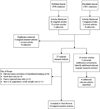Correlates of intentional tanning among adolescents in the United States: a systematic review of the literature
- PMID: 23601612
- PMCID: PMC4538996
- DOI: 10.1016/j.jadohealth.2012.09.021
Correlates of intentional tanning among adolescents in the United States: a systematic review of the literature
Abstract
Purpose: Exposure to ultraviolet radiation and a history of sunburn in childhood contribute to risk of skin cancer in adolescence and in adulthood, but many adolescents continue to seek a tan, either from the sun or from tanning beds (i.e., intentional tanning). To understand tanning behavior among adolescents, we conducted a systematic review of the literature to identify correlates of intentional tanning in the United States.
Methods: We included articles on original research published in English between January 1, 2001, and October 31, 2011, that used self-reported data on intentional tanning by U.S. adolescents aged 8 to 18 years and examined potential correlates of tanning behaviors. Thirteen articles met our criteria; all used cross-sectional survey data and quantitative methods to assess correlates of intentional tanning.
Results: Results indicate that multiple factors influence tanning among adolescents. Individual factors that correlated with intentional tanning include demographic factors (female sex, older age), attitudes (preferring tanned skin), and behaviors (participating in other risky or appearance-focused behaviors such as dieting). Social factors correlated with intentional tanning include parental influence (having a parent who tans or permits tanning) and peer influence (having friends who tan). Only four studies examined broad contextual factors such as indoor tanning laws and geographic characteristics; they found that proximity to tanning facilities and geographic characteristics (living in the Midwest or South, living in a low ultraviolet area, and attending a rural high school) are associated with intentional tanning.
Conclusions: These findings inform future public health research and intervention efforts to reduce intentional tanning.
Published by Elsevier Inc.
Conflict of interest statement
The authors report no potential conflicts of interest.
Figures
Similar articles
-
Artificial Intelligence-Driven Skin Aging Simulation as a Novel Skin Cancer Prevention.Dermatology. 2025;241(1):59-71. doi: 10.1159/000541943. Epub 2024 Oct 14. Dermatology. 2025. PMID: 39401496 Free PMC article.
-
College tanning behaviors, attitudes, beliefs, and intentions: A systematic review of the literature.Prev Med. 2017 Dec;105:77-87. doi: 10.1016/j.ypmed.2017.08.029. Epub 2017 Sep 1. Prev Med. 2017. PMID: 28867504
-
Education support services for improving school engagement and academic performance of children and adolescents with a chronic health condition.Cochrane Database Syst Rev. 2023 Feb 8;2(2):CD011538. doi: 10.1002/14651858.CD011538.pub2. Cochrane Database Syst Rev. 2023. PMID: 36752365 Free PMC article.
-
Prevalence and Location of Indoor Tanning Among High School Students in New Jersey 5 Years After the Enactment of Youth Access Restrictions.JAMA Dermatol. 2020 Nov 1;156(11):1223-1227. doi: 10.1001/jamadermatol.2020.2935. JAMA Dermatol. 2020. PMID: 32876658 Free PMC article.
-
Indoor tanning and non-melanoma skin cancer: systematic review and meta-analysis.BMJ. 2012 Oct 2;345:e5909. doi: 10.1136/bmj.e5909. BMJ. 2012. PMID: 23033409 Free PMC article.
Cited by
-
Making of Mobile SunSmart: Co-designing a Just-in-Time Sun Protection Intervention for Children and Parents.Int J Behav Med. 2021 Dec;28(6):768-778. doi: 10.1007/s12529-021-09987-9. Epub 2021 Apr 13. Int J Behav Med. 2021. PMID: 33846955 Free PMC article.
-
Ethnic and Gender Differences in Sun-Related Cognitions Among College Students: Implications for Intervention.Int J Behav Med. 2024 Feb 15. doi: 10.1007/s12529-024-10257-7. Online ahead of print. Int J Behav Med. 2024. PMID: 38360939
-
Indoor tanning among high school students in the United States, 2009 and 2011.JAMA Dermatol. 2014 May;150(5):501-11. doi: 10.1001/jamadermatol.2013.7124. JAMA Dermatol. 2014. PMID: 24577222 Free PMC article.
-
Correlates of sun protection behaviors among Hispanic children residing in a high UVR environment.Photodermatol Photoimmunol Photomed. 2017 Mar;33(2):75-83. doi: 10.1111/phpp.12287. Epub 2017 Jan 17. Photodermatol Photoimmunol Photomed. 2017. PMID: 27995652 Free PMC article.
-
Protocol for a cluster-randomized trial of a school-based skin cancer preventive intervention for adolescents.Contemp Clin Trials. 2024 May;140:107494. doi: 10.1016/j.cct.2024.107494. Epub 2024 Mar 6. Contemp Clin Trials. 2024. PMID: 38458557 Free PMC article.
References
-
- Rogers HW, Weinstock MA, Harris AR, et al. Incidence estimate of non-melanoma skin cancer in the United States, 2006. Arch Dermatol. 2010;146:283–287. - PubMed
-
- Guy GP, Jr, Ekwueme DU. Years of potential life lost and indirect costs of melanoma and non-melanoma skin cancer: A systematic review of the literature. Pharmacoeconomics. 2011;29:863–874. - PubMed
-
- Jemal A, Saraiya M, Patel P, et al. Recent trends in cutaneous melanoma incidence and death rates in the United States, 1992–2006. J Am Acad Dermatol. 2011;65(5 Suppl 1):S17–S25. e11–e13. - PubMed
-
- Bleyer A, Viny A, Barr R. Cancer in 15- to 29-year-olds by primary site. Oncologist. 2006;11:590–601. - PubMed
Publication types
MeSH terms
Grants and funding
LinkOut - more resources
Full Text Sources
Other Literature Sources
Medical
Miscellaneous


